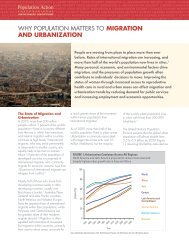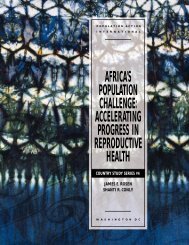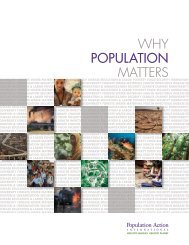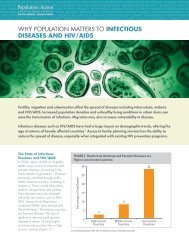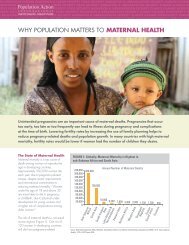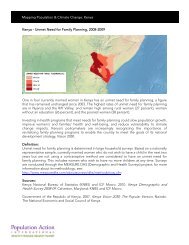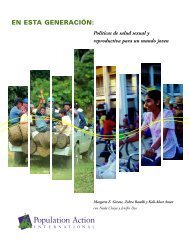Sustaining water, easing scarcity - Population Action International
Sustaining water, easing scarcity - Population Action International
Sustaining water, easing scarcity - Population Action International
You also want an ePaper? Increase the reach of your titles
YUMPU automatically turns print PDFs into web optimized ePapers that Google loves.
Billions of people<br />
Billions of people<br />
Billions of people<br />
10<br />
9<br />
8<br />
7<br />
6<br />
5<br />
4<br />
3<br />
2<br />
1<br />
0<br />
1995<br />
10<br />
9<br />
8<br />
7<br />
6<br />
5<br />
4<br />
3<br />
2<br />
1<br />
0<br />
1995<br />
11<br />
10<br />
9<br />
8<br />
7<br />
6<br />
5<br />
4<br />
3<br />
2<br />
1<br />
2000<br />
2000<br />
2005<br />
2005<br />
2010<br />
2010<br />
2015<br />
2015<br />
Figure 1<br />
WORLD POPULATION EXPERIENCING FRESHWATER SCARCITY,<br />
STRESS AND RELATIVE SUFFICIENCY 1995–2050<br />
Low <strong>Population</strong> Projection<br />
2020<br />
2020<br />
2025<br />
Medium <strong>Population</strong> Projection<br />
High <strong>Population</strong> Projection<br />
2025<br />
2030<br />
2030<br />
2035<br />
2035<br />
2040<br />
2040<br />
2045<br />
2045<br />
2050<br />
2050<br />
0<br />
1995 2000 2005 2010 2015 2020 2025 2030 2035 2040 2045 2050<br />
Charts: <strong>Population</strong> <strong>Action</strong> <strong>International</strong> Data Source: UN <strong>Population</strong> Division<br />
Scarcity Stress Relative Sufficiency<br />
These figures show the number of people living in countries experiencing <strong>water</strong> stress,<br />
<strong>scarcity</strong> or relative sufficiency at five-year increments under the UN’s low, medium<br />
and high population growth projections. As the population growth rate increases, so<br />
does the proportion of people living in countries experiencing <strong>water</strong> stress and <strong>scarcity</strong>.<br />
Summary<br />
As a result of an unexpected recent<br />
slowing of population growth, the<br />
United Nations projects that world<br />
population will be smaller by 450 million<br />
people in the year 2050 than it projected just<br />
three years ago. This reduction is primarily<br />
the result of significant declines in birthrates<br />
throughout the world. While this is good<br />
news by itself, reductions in population<br />
growth also have beneficial effects on the<br />
amount of renewable natural resources such<br />
as <strong>water</strong>, air and forests that are available to<br />
each of us. Using the United Nations 1996<br />
population projections, <strong>Population</strong> <strong>Action</strong><br />
<strong>International</strong> (PAI) has revised previous<br />
estimates and projections of the amount of<br />
fresh <strong>water</strong> available to each person in most<br />
of the world’s countries from today to the<br />
middle of the coming century. Based on<br />
this new range of population figures, PAI<br />
calculates that depending on how rapidly<br />
population grows, there will be between<br />
400 million and 1.5 billion fewer people<br />
living in <strong>water</strong> short countries in the year<br />
2050 than previously projected.<br />
This improvement in the assessment of<br />
the future availability of renewable fresh<br />
<strong>water</strong> has a wide range of potential benefits,<br />
from less pressure on fresh<strong>water</strong> ecosystems<br />
and underground aquifers to less tension<br />
between nations competing for shared <strong>water</strong><br />
resources. However, even under this<br />
improved scenario, renewable fresh<strong>water</strong><br />
<strong>scarcity</strong> will continue to remain a problem<br />
for millions of people around the world.<br />
There are currently more than 430 million<br />
people living in countries considered <strong>water</strong><br />
stressed. Moreover, PAI projects that by<br />
2050, the percentage of the world’s population<br />
living in <strong>water</strong> stressed countries will<br />
increase by anywhere from three to fivefold.<br />
3



